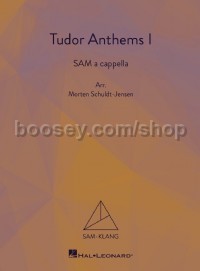Tudor Anthems I (SAM a Cappella)
Tudor Anthems I (SAM a Cappella)
Bulk Discounts Available
* Estimated price converted from UK retail price
This collection brings together five short anthems from the Tudor period. Three of these works can be ascribed to specific composers; the origins of the remaining two are less straightforward.
Richard Farrant was Master of the Choristers at St George’s Chapel, Windsor, where he organised the choristers into an acting company to perform musical plays for the court of Elizabeth I. Call to remembrance and Hide not thou thy face are two of very few compositions of his that survive. Both were very popular in the 16th century and neither have lost their appeal almost five centuries on. There is doubt whether Lord, for thy tender mercy’s sake was written by Farrant or the younger John Hilton the elder who, too, was a church musician interested in the theatre and chorister plays.
In How still and peaceful, the text of Scottish theologian Hugh Blair (1718–1800) has been put to music originally from Christopher Tye’s The Actes of the Apostles (1533), the only work to be published in the composer’s lifetime and the original source for the most popular setting of While shepherds watched their flocks. Let they merciful ears, O Lord is most likely by Thomas Mudd. In some sources the work has been incorrectly attributed to either Thomas Weelkes or Nicholas Strogers.
Editorial note: Some pieces in this volume feature brackets that comprise ‘ternary cells’ – cells of three beats – of differing lengths. Before the mid-17th century in the stile antico, it was common for each vocal line to have an independent stress pattern: a sequence of binary or ternary accentuations guided by the declamation of the text in order to give life to each voice.
Despite the non-legato of the individual single layer – created by elements including the musical articulation, the (hairpin) phrasing of the ternary cells and a natural text declamation – the constant displacement of stresses between the voices provides an overall feeling of flow right through to the next cadence, at which point the ‘cells’ come together.
Certain characteristics of this style, such as hemiolas and cadential conventions, continued in the following centuries and can be found in the music of Haydn, Mozart, Schubert and Brahms, and even later composers with an affinity for vocal polyphony. The voices in these SAM arrangements take on more than just their own polyphonic role, occasionally switching between parts to maintain the integrity of the original music.
Despite the initial challenges the removal of a part would suggest, choirs will reap the benefits of replicating the contrast and vitality of the original inner textural phrasing, and although the brackets and absence of normal bar lines may seem very different from a conventional edition, we are confident that any initial difficulties should be quickly overcome, and that the resulting quality and transparency of performance will be considerably more satisfying for both singer and listener.




